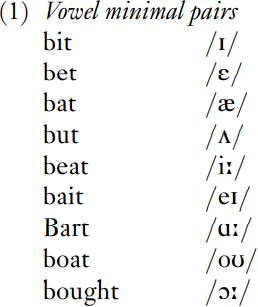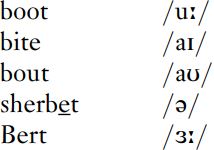


 Grammar
Grammar
 Tenses
Tenses
 Present
Present
 Past
Past
 Future
Future
 Parts Of Speech
Parts Of Speech
 Nouns
Nouns
 Verbs
Verbs
 Adverbs
Adverbs
 Adjectives
Adjectives
 Pronouns
Pronouns
 Pre Position
Pre Position
 Preposition by function
Preposition by function 
 Preposition by construction
Preposition by construction
 Conjunctions
Conjunctions
 Interjections
Interjections
 Grammar Rules
Grammar Rules
 Linguistics
Linguistics
 Semantics
Semantics
 Pragmatics
Pragmatics
 Reading Comprehension
Reading Comprehension|
Read More
Date: 2024-05-06
Date: 2024-12-26
Date: 2024-04-24
|
Establishing vowel contrasts
Minimal pairs and the commutation test are the main tools available to the phonologist in ascertaining phonemic contrast among both consonants and vowels. A minimal pair list for SSBE vowels appears in (1).


The list above provides evidence for almost all phonemically contrastive vowels of SSBE, with a very small number of exceptions. Since schwa only appears in unstressed syllables, where most of the other vowels cannot appear, we must make do with near-minimal comparisons in this case, contrasting the second, unstressed syllable of sherbet with the various stressed syllables in (1). The short vowels /υ/ and /ɒ/, and the centring diphthongs, which were listed as SSBE vowels, do not appear in the selected context /b-t/; but the additional data in (2) shows that /υ/ and /ɒ/ on the one hand, and the three centring diphthongs on the other, contrast both with one another and with representative members of the list in (1). Phonemic contrast is a transitive relationship, meaning that if phoneme a contrasts with phoneme b, and phoneme b contrasts with phoneme c, then phonemes a and c also contrast: this means that if a contrast can be established between one of the ‘left-out’ vowels and any vowel in (1), then that vowel can be taken as contrasting with all the vowels in (1).

Sets of minimal pairs like this may work very well for one accent, but not for another. For instance, minimal pairs like lock /k/ versus loch /x/, or witch /w/ versus which  will be relevant for many Scottish speakers in establishing the voiceless velar and labial-velar fricative phonemes, but both members of the pairs will have /k/ and /w/ respectively in many other accents of English. Although this was a rather minor issue for consonants, it is much more important in discussing vowel phoneme systems, since as we shall see, most accent variation in English involves vowels.
will be relevant for many Scottish speakers in establishing the voiceless velar and labial-velar fricative phonemes, but both members of the pairs will have /k/ and /w/ respectively in many other accents of English. Although this was a rather minor issue for consonants, it is much more important in discussing vowel phoneme systems, since as we shall see, most accent variation in English involves vowels.
|
|
|
|
التوتر والسرطان.. علماء يحذرون من "صلة خطيرة"
|
|
|
|
|
|
|
مرآة السيارة: مدى دقة عكسها للصورة الصحيحة
|
|
|
|
|
|
|
نحو شراكة وطنية متكاملة.. الأمين العام للعتبة الحسينية يبحث مع وكيل وزارة الخارجية آفاق التعاون المؤسسي
|
|
|